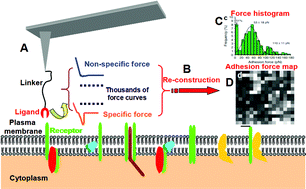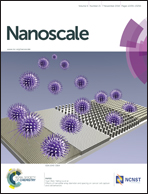In situ single molecule imaging of cell membranes: linking basic nanotechniques to cell biology, immunology and medicine
Abstract
The cell membrane, which consists of a viscous phospholipid bilayer, different kinds of proteins and various nano/micrometer-sized domains, plays a very important role in ensuring the stability of the intracellular environment and the order of cellular signal transductions. Exploring the precise cell membrane structure and detailed functions of the biomolecules in a cell membrane would be helpful to understand the underlying mechanisms involved in cell membrane signal transductions, which could further benefit research into cell biology, immunology and medicine. The detection of membrane biomolecules at the single molecule level can provide some subtle information about the molecular structure and the functions of the cell membrane. In particular, information obtained about the molecular mechanisms and other information at the single molecule level are significantly different from that detected from a large amount of biomolecules at the large-scale through traditional techniques, and can thus provide a novel perspective for the study of cell membrane structures and functions. However, the precise investigations of membrane biomolecules prompts researchers to explore cell membranes at the single molecule level by the use of in situ imaging methods, as the exact conformation and functions of biomolecules are highly controlled by the native cellular environment. Recently, the in situ single molecule imaging of cell membranes has attracted increasing attention from cell biologists and immunologists. The size of biomolecules and their clusters on the cell surface are set at the nanoscale, which makes it mandatory to use high- and super-resolution imaging techniques to realize the in situ single molecule imaging of cell membranes. In the past few decades, some amazing imaging techniques and instruments with super resolution have been widely developed for molecule imaging, which can also be further employed for the in situ single molecule imaging of cell membranes. In this review, we attempt to summarize the characteristics of these advanced techniques for use in the in situ single molecule imaging of cell membranes. We believe that this work will help to promote the technological and methodological developments of super-resolution techniques for the single molecule imaging of cell membranes and help researchers better understand which technique is most suitable for their future exploring of membrane biomolecules; ultimately promoting further developments in cell biology, immunology and medicine.


 Please wait while we load your content...
Please wait while we load your content...